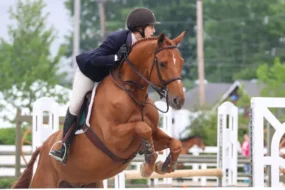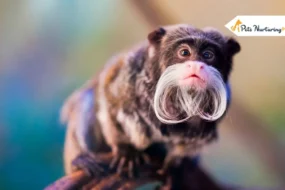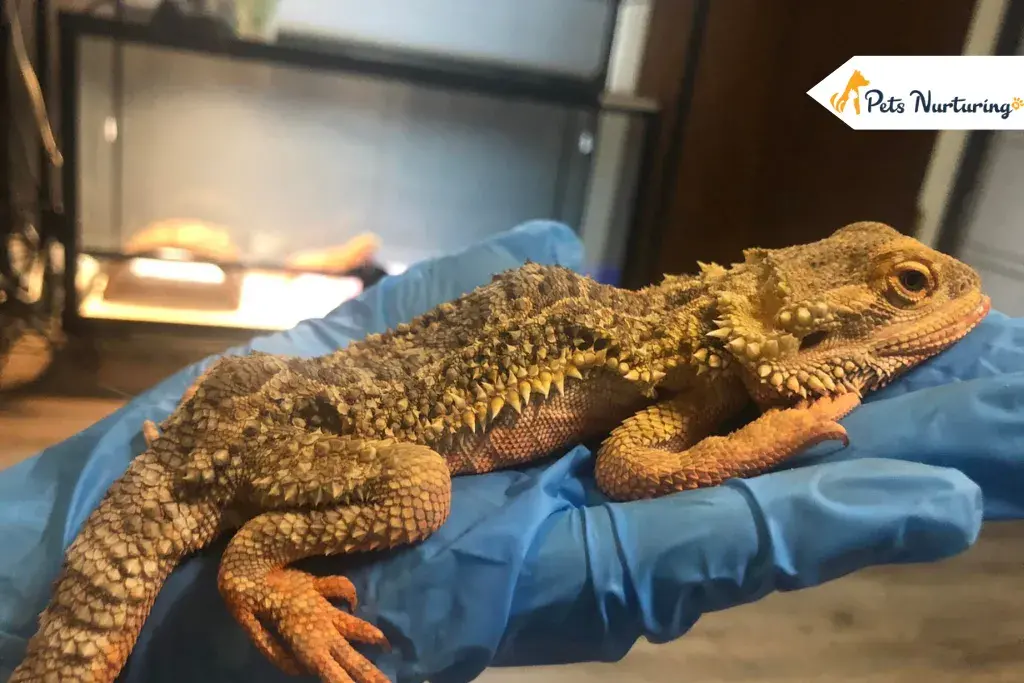
Bearded dragons stand true to their name and adorn an armor of spiny scales characteristic of a reptile. They also have spikes under their chin, referred to as the ‘beard’, which puffs up when they are in a particular mindset. A Full grown Bearded dragon is one of the most popular pets among the reptilian class. There are eight known species of beardies but the one most popularly seen among pet lovers and reptile enthusiasts is the Pogona vitticeps also known as the central bearded dragon.
Although we’ll mainly be focusing on the Pogona species, we’ll discuss how big other species of bearded dragons get. Other basic parameters like temperament, diet, habitat, etc remain pretty much similar throughout all 8 species.
Bearded dragons gained popularity as pet reptiles due to their gentle and social persona, inquisitive nature, and daytime activity. They are easy to tame and interesting to watch.
Species Overview
Full Grown Bearded Dragon
Scientific name: Pogona vitticeps
Common names: Beardies, inland bearded dragon, central bearded dragon, bearded dragon.
Class : Reptile
Type: Cold-blooded
Habitat : Warm and arid climatic zones
Temperament : Docile, gentle.
Life span : 6 to 10 years
Size : Up to 24 inches long
Diet : Omnivorous: Greens, vegetables, insects, fruits.
Housing : Juvenile: 40-gallon tank per dragonAdult: 100-gallon tank/enclosure per dragon
Weight : 400 to 500 grams
The most curious question among the reptile enthusiasts interested in getting a bearded dragon is ‘How big do bearded dragon get?’ and the answer varies depending on the species one chooses to house.
If you go for the popular choice of a full size bearded dragon, that is the Pogona vitticeps, the answer to ‘How big do bearded dragons get?’ is 16 to 24 inches.
Sizes for the other 7 varieties are as follows:
- Pogona barbata – 24 Inches
- Pogona henrylawsoni – 12 Inches
- Pogona microlepidota – 6 Inches
- Pogona minor minima – 12 Inches
- Pogona minor minor – 18 Inches
- Pogona minor mitchelli – 18 Inches
- Pogona nullarbor – 14 Inches
‘How big do bearded dragon get?’ isn’t the only question you must be asking. You must know what are the factors that affect the bearded dragon full grown, as getting it right will help you attain maximum growth and a healthy dragon.
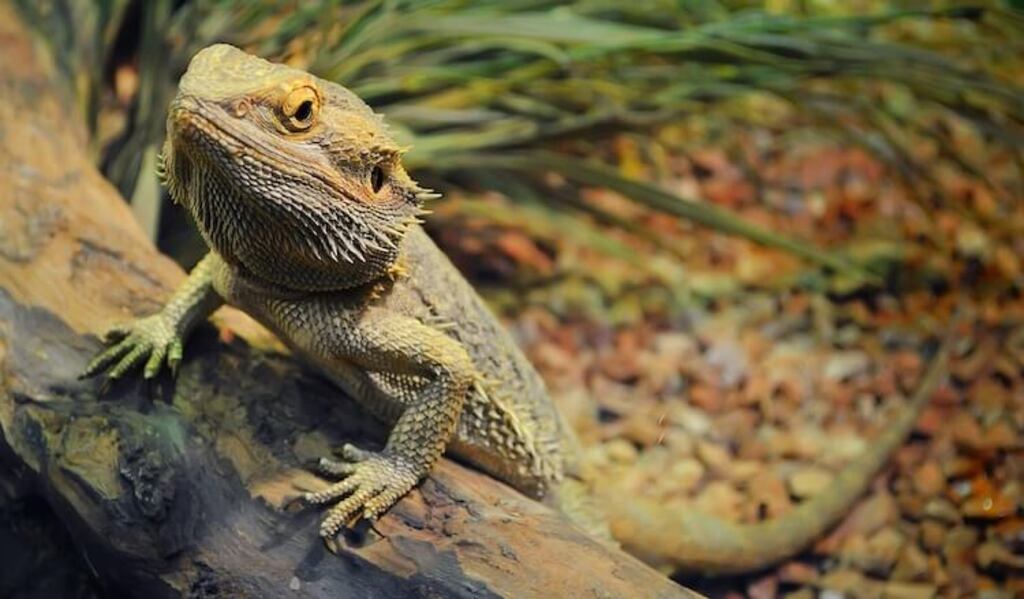
Factors Affecting the Growth of a Bearded Dragon Are as Follows
- Sex: Most species show a size variation among the sexes with males usually being larger than the females and the beardies are no different in this case. If you have both sexes of the same species, your male beardie will be comparatively larger than your female.
- Species and breed (genetic factors): As mentioned above (in the species-wise size), with evolution, all varieties have developed differently and have their variations in phenotypic expressions, for example, size.
- Diet: Diet plays an extremely important role in the growth of any living organism. A malnourished or poorly nourished beardie will remain much smaller than the average size, whereas a beardie getting all-around balanced nutrition will attain its maximum growth.
- Environmental factors including care and maintenance: animals adapt to their environment, if you provide less space and expose your bearded dragon to harsh/unsuitable or poor environmental conditions, they would not be able to achieve their full size. Whereas, the dragons growing in a healthy and suitable environment, thrive.
We also get a lot of people asking for ‘bearded dragon growth chart’ as just knowing how big your beardie will get isn’t all. Being aware of the approximate bearded dragon size and weight that should be attained at various stages of growth helps you keep track of their health.
By knowing how big your beardie should be by a certain age or by tracking their growth, you can also find out if they are underweight or obese and accordingly bring the right changes in your feeding and management.
Referring to the bearded dragon growth chart will provide you with an opportunity to timely identify and correct any loopholes in the upbringing of your reptile.
Bearded Dragon Growth Chart
| Age (in months) | Weight (in grams) | Length (in inches) |
|---|---|---|
| 0 to 1 | 3 to 5 | 2 to 3 |
| 1 | 4 to 6 | 3 to 4 |
| 2 | 8 to 40 | 5 to 9 |
| 3 | 20 to 60 | 9 to 11 |
| 4 | 40 to 80 | 10 to 12 |
| 5 | 80 to 120 | 12 to 16 |
| 6 | 130 to 180 | 15 to 18 |
| 7 | 230 to 280 | 15 to 20 |
| 8 | 250 to 330 | 16 to 22 |
| 9 | 280 to 360 | 17 to 23 |
| 10 to 12 | 350 to 450 | 17 to 24 |
| 12+ | 400 to 500 | 17 to 24 |
Now that you know all about how big bearded dragons get and the bearded dragon full size chart, let’s dive in to learn more about them so that you do not face any difficulty while you raise your beautiful dragons.
Here we’ll be referencing the popular pet species that is the Pogona vitticeps.
Origin and Habitat
With Inland Australia as their native habitat and place of origin, the range of central bearded dragons extend across most of Australia. These moderately sized lizards prefer warm and arid climatic zones. They are inhabitants of the scrublands, savannas, deserts, and subtropical woodlands.
Full grown Bearded dragons are cold-blooded animals, meaning they cannot regulate their body temperature from within (like us) and rely on external sources to stay warm. This is one of the biggest reasons why a warm habitat is a must for a beardie.
In the hot regions which is their natural habitat, they bask in the sun when they need to warm themselves up and hide underground in a borrow to cool themselves down or to avoid predators.
You can also find them chilling on tree branches as they are semi-arboreal reptiles that live on both lands and trees (occasionally).
Appearance

They are medium-sized lizards found in a range of colours. Although, light to dark brown variety is the most commonly seen. Bearded dragons as their name suggests have a spiky beard-like collar around their neck that puffs up when they want it to.
The tail of a bearded dragon is thick, spiky, and long. Irrespective of their intimidating looks and the name (dragon), these reptiles are very docile which makes them pretty suitable as pets.
Temperament of a Bearded Dragon
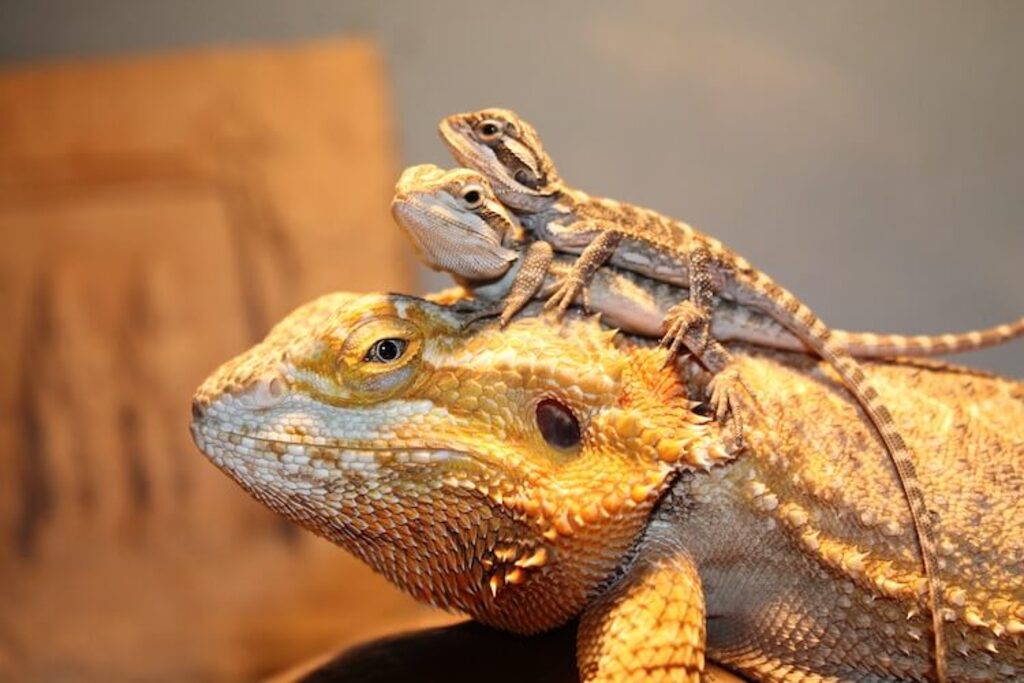
Bearded dragons are most active during the day. Males must be housed separately as they are territorial in nature and any threat or invasion into their territory by another male may lead to a fight. Males may even fight over food or mate. Some are even known to attack females if the females try to be dominating.
The spines of their beard are usually flat but if they feel intimidated or threatened, they expand their throat and the spines stand up to make them look big and intimidating, this is often followed with a hiss. They can also change the colour of their beard, which is used to communicate with other lizards. Another way of communicating is bobbing their heads. A slow bob shows submission, whereas a fast one signals dominance.
Overall the beardies are docile and keepers rarely ever see them being aggressive. They tolerate and adapt well to handling, some even enjoy curling up on their keeper’s lap or perching on their shoulder. They have an interesting and inquisitive personality, which makes them fun to observe.
When temperatures drop, some beardies may stop eating and only consume water between long intervals. This dormant phase is a form of hibernation shown by bearded dragons.
Diet
Unlike most other pets, taking care of a fully grown bearded dragon’s diet is pretty simple as they are usually not picky when it comes to food. They are omnivores which also increases the options of food items that you can offer.
Beardies feed on leaves, flowers, veggies, and occasionally on small insects and rodents. They devour the smaller lizards and also enjoy feeding on hard-shelled insects like the Beatles (as the beardies have strong jaws).
Moreover, they also enjoy consuming a variety of fruits. But Can Bearded Dragons Eat Bananas? As the bananas are rich in fiber and can help to digest food. So, Bananas can occasionally be part of their diet. However, bananas should not be served as a staple item. They should only be offered as a treat in small amounts alongside other proteins and greens that are more nutritionally beneficial.
A hatchling or a baby bearded dragon is just 2 to 3 inches long and weighs about 2 to 4 grams and will gain up to 40 grams in the initial 2 months during this time. Their protein requirement is high and thus their diet must include more insects than vegetables or fruits.
A juvenile dragon aged 2 to 5 months needs proper nutrition as these five months of their growth are crucial since they go from 8 grams to somewhere around 250 grams. Again a lot of protein-rich food must be fed to them during this period. You can also supplement their diet with vitamin D and calcium.
Housing
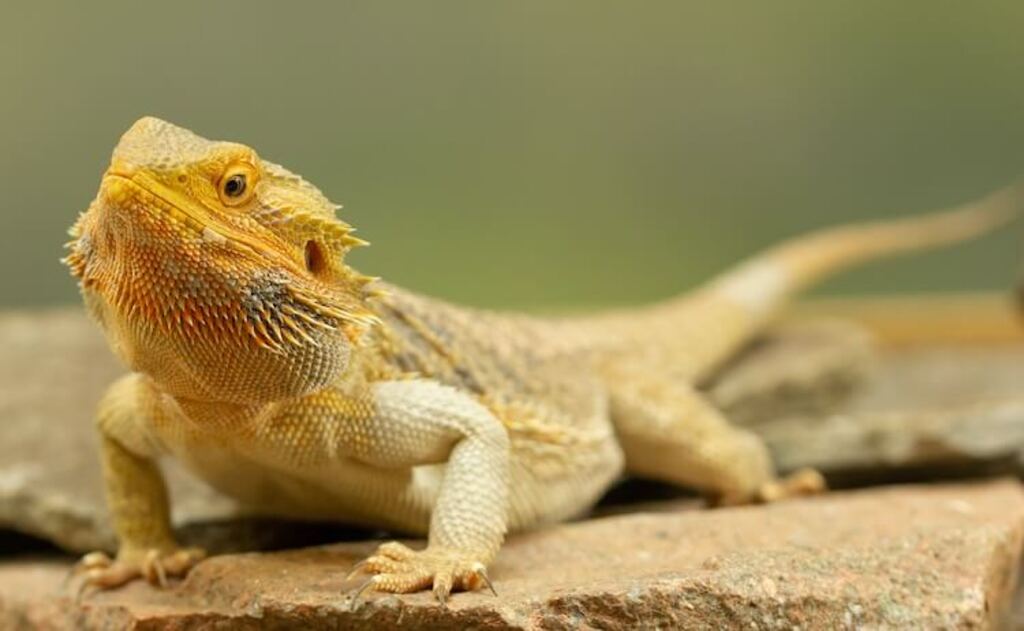
Size of Enclosure
A juvie can be housed in a 40-gallon tank but a full grown bearded dragon may need a tank of 75 to 100-gallon capacity. Their tank must have a cover on top to prevent escape.
Enrichment
You can add rocks, logs and branches to their enclosure as they are semi-arboreal and enjoy climbing. Always provide a basking area with a comparatively higher temperature and hiding spots such as boxes or hollow logs for them to have their space and feel comfortable.
Temperature
Temperature is one of the important factors that need to be maintained in their tank. On the cooler side of the tank or during the night times, the temperatures can be in the range of 65 to 85 degrees Fahrenheit. In the basking region, maintain the temperature between 95 to 110 degrees Fahrenheit.
Desired temperatures and heat can be provided using mercury vapour bulbs, ceramic heaters, UVB lights, under tank heaters etc. A thermometer can be used in the tank to keep a track of the temperature.
Light
Maintain a day-night cycle of 12 hours each for your beardie. Provide UVB light directly through the screen top and not through glass. Exposure to sunlight is a natural and beneficial way of providing light but make sure you don’t end up overheating them by placing them in a tank outside.
Substrate
Substrate or the litter material at the base of the enclosure can be in the form of paper towels, sand or reptile carpets. For juveniles, sand must be avoided as there is a risk of ingestion which may lead to impaction.
Sand can be used for adults as it allows them to dig, which they enjoy. It also makes scooping their poop easy if you use sand. Do not use shells of nuts, corn cob or wood pieces as they can become a choking hazard.
Humidity
35 to 45% of humidity must be maintained in their tank. You can mist their tank to achieve these levels. If you live in a highly humid area, this may be difficult to maintain. Use a hydrometer to keep a check on this parameter.
Final Thoughts
Providing the correct environment, healthy diet and good management will help your dragon attain their best possible size as well as health parameters, so make sure you never lack in these zones.
Read More:










